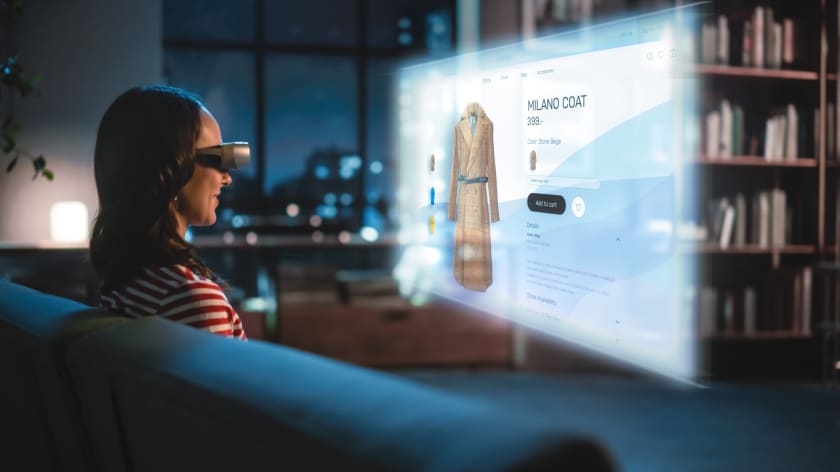5 Digital Trends Reshaping the Business of Fashion



Summary: The fashion business is changing faster than ever before, and it is critical for brands and companies to stay on top of digital transformations to survive. 90s fashion style or other fashion trends may come and go, but digitization remains at the crux of innovation.
From the era of 90s fashion style and high-street fashion to the rise of e-commerce, digitization has come a long way. While the retail industry took a major hit during the pandemic, it picked up pace in 2022. The revenue of the fashion market was approximately $1.53 trillion in 2022. According to the Consumer Market Outlook, this number is forecasted to increase to $2 trillion by 2027.
Today, fashion technology is growing faster than ever. Robots are cutting and sewing fabrics and AI algorithms are predicting style trends on e-commerce websites. These innovations show how technology is personalizing, automating, and changing the landscape of the fashion industry.
To open more revenue streams, fashion brands are coming together with tech-solution providers to define digital transformation. In this blog, let’s explore which are the biggest digital trends that will be reshaping the business of fashion.
1. Wearables - The Paradigm Shifters in Fashion Tech
From the early days of Fitbit to the newest Apple Watch, fashion consumers have shown an affinity toward wearables. Fashion market leaders have started to notice this trend and have chosen to make wearables more fashionable and functional. Google’s smartwatch operating system — the Wear OS — is now available in premium and luxury watch brands like Fossil, Huawei, Diesel, and Michael Kors.
Smart jewelry like rings and bracelets are being designed by brands like Oura. They help to track physical activity, heart rate, sleep patterns, temperature, and more. Another example of a trending wearable is the Nike Adapt sneaker line. These smart shoes are self-lacing and allow the wearer to control the fit and choose shoe lighting via an app.

2. 3D Body Scanning - A Sustainable Digital Transformation Strategy
Fashion brands have started to adopt virtual body-measurement technology to create clothes that have accurate and inclusive sizes. Before fast fashion, tailoring and custom-made clothes were commonplace. However, customization is a challenge on large scale. This is where the 3D body scanning technology hits it out of the park.
This technology operates by capturing images of an individual from different angles and sewing them together to construct a 3D model. One needs to take pictures of themselves on the brand’s app, and custom-fit garments can be made according to the measurements captured by the scanner. Brands like Unspun, Weekday, and Atalye have adopted this digital trend that is transforming their business and reducing fashion waste.

3. Novel Fabrics - The Next-gen Textile
Novel fabrics are a type of cloth made of high-tech materials. Fabrics that change color may be on the horizon too. While color-shifting T-shirts and rings had their 30 seconds of fame in the 90s fashion style era, the latest iterations of this technology are far more refined.
Google’s Jacquard Tech has been integrating AI into fashion for some time now. This team behind Jacquard has also developed a technology called Ebb. This tech creates color-changing fabrics that could be programmed to shift with your mood or surroundings.
There is even a technology called bioceramic printing, which can be integrated with fabrics. This technology mixes with the body's temperature to create far infrared radiation, which is supposed to alleviate inflammation, enhance blood circulation, and help muscles recover faster. The magic of novel fabrics when introduced into the mainstream fashion industry will be groundbreaking.
4. Digital Twins - Always Identical, Always Reliable
Digital twins are virtual counterparts of real objects, places, and processes. This digital trend is developed to help fashion brands reduce textile waste, speed up their production, and increase SKU transparency. Digital Twins have data based on the characteristics of the real-life object. In fashion, a shirt’s digital twin would comprise information about its fabric, design features, stitching style, size, and even the source of its textiles.
However, when it comes to the manufacturing process, digital twins can become a game-changer. For instance, a fabric-cutting machine placed in a room can be replicated virtually. The real-time equipment is attached to sensors that can give data about the machine’s output, health, and speed. When AI is integrated to analyze this data, it can forecast production volumes, machine downtimes, and other details.
Digital twins can be made of entire production lines too. Thus, when a process breaks down in real time, the digital twin of the production line can identify which factors were involved. When this technology becomes ubiquitous, it will change the way the fashion industry operates.

5. Metaverse - The Future of VR Shopping
As more brands and consumers are going digital, the emergence of a ‘metaverse mall’ seems to be a reality in the near future. These malls would create newer sales channels and AR spaces in which customers could talk to each other, browse digital fashion trends, and enjoy an immersive VR experience.
By establishing a store within the metaverse, fashion brands can reach millions of customers from a single shop. A customer could “walk” into a metaverse mall, buy something, and later collect it at the physical store. However, creating the metaverse requires massive resources, engineering talent, and money. This concept will take a while to come to fruition and will need major efforts from tech giants.

Tech transformation in the fashion industry is inevitable and will contribute to the sector's growth in the upcoming decade. In 2021, fashion brands have invested 1.8% of their revenue in tech, and by 2030, it is expected to rise up to 3%. It is wise for fashion entrepreneurs to invest in digital trends to create an ever-growing revenue stream.
If you need guidance on implementing fashion technologies for your brand, Fashinza can help you with smart and hassle-free operations.
Get in touch with us for an AI-guided choice of suppliers and real-time monitoring of shipments.
Key Takeaways
- In the wake of the pandemic, the fashion industry saw a massive shift in the buying behavior of its consumer. Among the fashion customers who moved to online shopping in 2021, 48% stated the pandemic as the reason, while 27% cited convenience, and the remaining 11% mentioned better product availability and promotions.
- Overall, the shift from brick-and-mortar to e-commerce has been well-received and these futuristic digital trends can only be expected to take the fashion industry to another level.



















